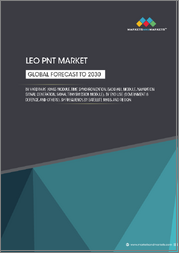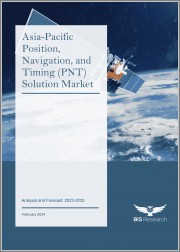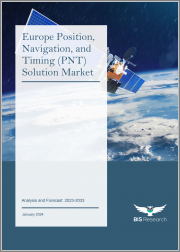
|
시장보고서
상품코드
1628195
어슈어드 PNT 시장 기회, 성장 촉진요인, 산업 동향 분석, 예측(2025-2034년)Assured PNT (Positioning, Navigation, and Timing) Market Opportunity, Growth Drivers, Industry Trend Analysis, and Forecast 2025 to 2034 |
||||||
세계 어슈어드 PNT(포지셔닝, 내비게이션, 타이밍) 시장은 2024년 6억 6,560만 달러로 평가되며, 2025년부터 2034년까지 연평균 28.2%로 성장할 것으로 예상됩니다.
이러한 성장은 주로 신뢰할 수 있는 타이밍 포지셔닝 솔루션을 필요로 하는 중요 인프라에 대한 의존도가 높아졌기 때문입니다. 통신, 에너지, 금융, 국방 등의 산업은 원활한 운영을 보장하기 위해 정확한 시간 동기화에 의존하고 있습니다. 그러나 내비게이션과 타이밍을 위한 세계 포지셔닝 시스템(GPS)의 채택이 증가함에 따라 신호 방해, 스푸핑, 혼란 등의 잠재적 취약성에 대한 우려가 커지고 있습니다.
이러한 문제를 해결하기 위해 어슈어드 PNT 시스템에 대한 수요가 증가하고 있습니다. 이러한 시스템은 여러 기술을 활용하여 탄력성과 이중화를 제공하고, 하나의 소스에 장애가 발생하더라도 지속적인 작동을 보장할 수 있도록 설계되어 있습니다. 첨단 솔루션은 다중 소스 보증과 제로 트러스트 보안 모델을 통합하여 신뢰성을 높이고 GPS 의존에 따른 리스크를 줄입니다.
보안 PNT 시장은 안전하고 통합된 솔루션에 대한 요구가 증가함에 따라 빠르게 변화하고 있습니다. 방위, 통신, 스마트 인프라 등의 분야에서 GPS와 위성항법시스템(GNSS)에 대한 의존도가 높아짐에 따라 업계는 하이브리드 시스템으로 전환하고 있습니다. 이러한 솔루션은 서로 다른 GNSS 별자리의 신호를 혼합하고 중단 없는 서비스를 보장하기 위해 지상 기반 확장 기능을 통합하고 있습니다. 세계가 더욱 상호연결됨에 따라 백업 시스템과 강력한 사이버 보안의 필요성이 PNT 분야의 추가 혁신을 촉진하고 있습니다.
| 시장 범위 | |
|---|---|
| 시작 연도 | 2024년 |
| 예측 연도 | 2025-2034년 |
| 시작 금액 | 6억 6,560만 달러 |
| 예상 금액 | 79억 달러 |
| CAGR | 28.2% |
플랫폼별로 시장은 항공, 육상, 해군으로 구분되며, 항공 부문이 가장 빠르게 성장하여 2034년까지 연평균 28.5% 이상의 CAGR로 확대될 것으로 예측됩니다. 항공 산업은 정확한 항법 및 타이밍을 필요로 하며, 특히 자율 기술과 네트워크화된 항공 시스템을 탐색하고 있기 때문에 고급 PNT 솔루션의 개발을 촉진하고 있습니다.
부품의 경우, 시장에는 원자시계, 안테나, 센서, 트랜스폰더, 수신기 등이 포함됩니다. 원자시계는 2024년 시장 점유율 27% 이상을 차지하며 큰 폭의 성장이 예상됩니다. 산업 전반에 걸쳐 초정밀 타이밍에 대한 수요가 증가하면서 정확성, 신뢰성, 에너지 효율성 향상에 초점을 맞춘 원자시계 기술의 발전을 촉진하고 있습니다.
북미가 세계 시장을 주도하고 있으며, 미국은 2034년까지 35억 달러가 넘을 것으로 예상됩니다. 특히 국방 및 국가 안보를 위한 탄력적인 PNT 솔루션에 대한 투자가 이 지역의 성장을 주도하고 있습니다. 위성, 지상, 관성 기술을 결합한 통합 PNT 시스템의 개발은 중요한 부문 전반에서 안정적인 운영을 보장하기 위한 주요 발전입니다.
목차
제1장 조사 방법과 조사 범위
제2장 주요 요약
제3장 업계 인사이트
- 생태계 분석
- 밸류체인에 영향을 미치는 요인
- 이익률 분석
- 파괴
- 향후 전망
- 제조업체
- 유통업체
- 공급업체 상황
- 이익률 분석
- 주요 뉴스와 대처
- 규제 상황
- 영향요인
- 성장 촉진요인
- 긴급 서비스, 군사, 항공우주 등의 용도에서 신뢰성 높은 정보에 대한 수요 증가
- 자율주행차와 로봇공학 성장
- 중요한 오퍼레이션의 GPS에 대한 의존도 증가
- 보안 향상을 위한 첨단 기술 이용 확대
- 통신의 진보
- 업계의 잠재적 리스크와 과제
- 높은 개발·훈련 비용
- 적절한 규제나 기준의 결여
- 성장 촉진요인
- 성장 가능성 분석
- Porters 분석
- PESTEL 분석
제4장 경쟁 구도
- 소개
- 기업 점유율 분석
- 경쟁 포지셔닝 매트릭스
- 전략 전망 매트릭스
제5장 시장 추정과 예측 : 구성요소별, 2021-2034년
- 주요 동향
- 원자시계
- 안테나
- 트랜스폰더
- 센서
- 파워 앰프
- 리시버
- 기타
제6장 시장 추정과 예측 : 플랫폼별, 2021-2034년
- 주요 동향
- 항공기
- 군용기
- 전투기
- 특수 임무기
- 군용 헬리콥터
- 무인 시스템
- 군용기
- 육상
- 전투 차량
- 주력전차
- 병력수송장갑차
- 장갑수륙양용차
- 기타
- 무인지상차량
- 전투 차량
- 해군
- 구축함
- 프리깃
- 코르벳함
- 잠수함
제7장 시장 추정과 예측 : 최종사용별, 2021-2034년
- 주요 동향
- 방위
- 국토안보
제8장 시장 추정과 예측 : 지역별, 2021-2034년
- 주요 동향
- 북미
- 미국
- 캐나다
- 유럽
- 영국
- 독일
- 프랑스
- 이탈리아
- 스페인
- 러시아
- 아시아태평양
- 중국
- 인도
- 일본
- 한국
- 호주
- 라틴아메리카
- 브라질
- 멕시코
- 중동 및 아프리카
- 남아프리카공화국
- 사우디아라비아
- 아랍에미리트
제9장 기업 개요
- BAE Systems
- Curtiss-Wright
- General Dynamics
- Hexagon
- Honeywell
- Israel Aerospace Industries
- L3Harris Technologies
- Leonardo
- Lockheed Martin
- Northrop Grumman
- Raytheon Technologies
- Spirent Communications
- Thales
The Global Assured PNT (Positioning, Navigation, And Timing) Market was valued at USD 665.6 million in 2024 and is anticipated to grow at a robust CAGR of 28.2% from 2025 to 2034. This growth is primarily driven by the increasing dependence on critical infrastructure, which requires reliable timing and positioning solutions. Industries such as telecommunications, energy, finance, and defense depend on accurate time synchronization to ensure seamless operations. However, the rising adoption of Global Positioning Systems (GPS) for navigation and timing has raised concerns about potential vulnerabilities, including signal jamming, spoofing, and disruptions.
To address these challenges, the demand for Assured PNT systems is rising. These systems are designed to provide resilience and redundancy by leveraging multiple technologies and ensuring continuous operation even if one source fails. Advanced solutions now integrate multi-source assurance and zero-trust security models to enhance reliability and mitigate risks associated with GPS dependency.
The assured PNT market is transforming rapidly to meet the growing need for secure and integrated solutions. As the reliance on GPS and Global Navigation Satellite Systems (GNSS) increases across sectors like defense, telecommunications, and smart infrastructure, the industry is shifting towards hybrid systems. These solutions blend signals from different GNSS constellations and incorporate ground-based enhancements to ensure uninterrupted service. With the world becoming more interconnected, the necessity for backup systems and strong cybersecurity drives further innovation in the PNT sector.
| Market Scope | |
|---|---|
| Start Year | 2024 |
| Forecast Year | 2025-2034 |
| Start Value | $665.6 Million |
| Forecast Value | $7.9 Billion |
| CAGR | 28.2% |
By platform, the market is segmented into air, land, and naval, with the air segment projected to witness the fastest growth, expanding at a CAGR of over 28.5% through 2034. The aviation industry's need for precise navigation and timing pushes the development of advanced PNT solutions, particularly as the sector explores autonomous technologies and networked air systems.
In terms of components, the market includes atomic clocks, antennas, sensors, transponders, receivers, and more. Atomic clocks held over 27% of the market share in 2024 and are expected to grow significantly. The increasing demand for ultra-precise timing across industries is driving advancements in atomic clock technologies, with a focus on enhancing accuracy, reliability, and energy efficiency.
North America leads the global market, with the U.S. expected to surpass USD 3.5 billion by 2034. Investments in resilient PNT solutions, particularly for defense and national security, propel regional growth. The development of integrated PNT systems that combine satellite, terrestrial, and inertial technologies is key to ensuring reliable operations across critical sectors.
Table of Contents
Chapter 1 Methodology & Scope
- 1.1 Market scope & definitions
- 1.2 Base estimates & calculations
- 1.3 Forecast calculations
- 1.4 Data sources
- 1.4.1 Primary
- 1.4.2 Secondary
- 1.4.2.1 Paid sources
- 1.4.2.2 Public sources
Chapter 2 Executive Summary
- 2.1 Industry synopsis, 2021-2034
Chapter 3 Industry Insights
- 3.1 Industry ecosystem analysis
- 3.1.1 Factor affecting the value chain
- 3.1.2 Profit margin analysis
- 3.1.3 Disruptions
- 3.1.4 Future outlook
- 3.1.5 Manufacturers
- 3.1.6 Distributors
- 3.2 Supplier landscape
- 3.3 Profit margin analysis
- 3.4 Key news & initiatives
- 3.5 Regulatory landscape
- 3.6 Impact forces
- 3.6.1 Growth drivers
- 3.6.1.1 Increase in demand for reliable information in applications such as emergency services, military, and aerospace
- 3.6.1.2 Growth in autonomous vehicles and robotics
- 3.6.1.3 Increasing reliance on GPS for critical operations
- 3.6.1.4 Growing use of advanced technologies to improve security
- 3.6.1.5 Telecommunications advancements
- 3.6.2 Industry pitfalls & challenges
- 3.6.2.1 High development and training cost
- 3.6.2.2 Lack of proper regulations and standards
- 3.6.1 Growth drivers
- 3.7 Growth potential analysis
- 3.8 Porter's analysis
- 3.9 PESTEL analysis
Chapter 4 Competitive Landscape, 2024
- 4.1 Introduction
- 4.2 Company market share analysis
- 4.3 Competitive positioning matrix
- 4.4 Strategic outlook matrix
Chapter 5 Market Estimates & Forecast, By Components, 2021-2034 (USD Million)
- 5.1 Key trends
- 5.2 Atomic clocks
- 5.3 Antennas
- 5.4 Transponders
- 5.5 Sensors
- 5.6 Power amplifiers
- 5.7 Receivers
- 5.8 Others
Chapter 6 Market Estimates & Forecast, By Platform, 2021-2034 (USD Million)
- 6.1 Key trends
- 6.2 Air
- 6.2.1 Military aircraft
- 6.2.1.1 Fighter aircraft
- 6.2.1.2 Special mission aircraft
- 6.2.2 Military helicopters
- 6.2.3 Unmanned systems
- 6.2.1 Military aircraft
- 6.5 Land
- 6.5.1 Combat vehicles
- 6.5.1.1 Main battle tanks
- 6.5.1.2 Armored personnel carriers
- 6.5.1.3 Armored amphibious vehicles
- 6.5.1.4 Others
- 6.5.2 Unmanned ground vehicles
- 6.5.1 Combat vehicles
- 6.6 Naval
- 6.6.1 Destroyers
- 6.6.2 Frigates
- 6.6.3 Corvettes
- 6.6.4 Submarines
Chapter 7 Market Estimates & Forecast, By End Use, 2021-2034 (USD Million)
- 7.1 Key trends
- 7.2 Defense
- 7.3 Homeland security
Chapter 8 Market Estimates & Forecast, By Region, 2021-2034 (USD Million)
- 8.1 Key trends
- 8.2 North America
- 8.2.1 U.S.
- 8.2.2 Canada
- 8.3 Europe
- 8.3.1 UK
- 8.3.2 Germany
- 8.3.3 France
- 8.3.4 Italy
- 8.3.5 Spain
- 8.3.6 Russia
- 8.4 Asia Pacific
- 8.4.1 China
- 8.4.2 India
- 8.4.3 Japan
- 8.4.4 South Korea
- 8.4.5 Australia
- 8.5 Latin America
- 8.5.1 Brazil
- 8.5.2 Mexico
- 8.6 MEA
- 8.6.1 South Africa
- 8.6.2 Saudi Arabia
- 8.6.3 UAE
Chapter 9 Company Profiles
- 9.1 BAE Systems
- 9.2 Curtiss-Wright
- 9.3 General Dynamics
- 9.4 Hexagon
- 9.5 Honeywell
- 9.6 Israel Aerospace Industries
- 9.7 L3Harris Technologies
- 9.8 Leonardo
- 9.9 Lockheed Martin
- 9.10 Northrop Grumman
- 9.11 Raytheon Technologies
- 9.12 Spirent Communications
- 9.13 Thales

















